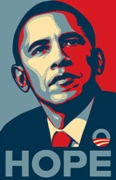The Obama “Hope” Poster Case — AP Strikes Back

 (This is the fifth in a series of posts on Fairey v. Associated Press. See below for other posts in the series.)
(This is the fifth in a series of posts on Fairey v. Associated Press. See below for other posts in the series.)
Today, the AP filed its response to the Fairey complaint—and as I predicted, the AP is asserting counterclaims for copyright infringement. Like Fairey’s complaint, the AP’s counterclaims go well beyond merely stating a cause of action, and attempt to win the battle for positive publicity as well. (Note to my Civ Pro students: Take a look at these pleadings if you want to see skillful examples of what I was talking about when I mentioned complaints that go beyond a “short and plain statement.”) Both sides in this case have their eye not just on the law, but on the ordinary, nonlegal intuitions of the press, the judge, the jury, scholars, and bloggers such as myself. (Indeed, I got a copy of AP’s press release by email. To Fairey’s attorneys: Feel free to reciprocate!)
I have a few quick observations.
